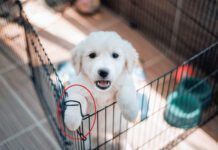In addition to planning for and providing your new pup with all the training and management she needs to learn basic good manners and how to live in your home, responsible owners also engineer and oversee their puppy’s socialization — puppy playtime — in order to help her mature into a dog who is unafraid of and friendly with other dogs. Your dog needs as much puppy playtime as it takes to get her to be unafraid and friendly with people, other dogs and places.
The good news is that most pups come with some prior play experience – they’ve had littermates to play with for the first several weeks of their lives. Your baby dog may need to learn how to play with humans, but unless she was a singleton pup (an only child), she has probably already learned some good canine play skills. (See Sidebar: Teaching Your Play-Deprived Puppy How to Play.)
Play dates are a great idea – either in a well-run puppy kindergarten class or in arranged play dates with appropriate puppy pals. Opportunities for puppy playtime with other puppies will keep your pup’s play skills well-honed, and help her develop other important social skills as she matures.
Keep in mind that even at a very young age, dogs have different play styles and personalities. A robust, energetic, assertive pup will want to play with other resilient, active pups who appreciate her active play style. Conversely, if your puppy is more laid back or shy, she’ll need to play with lower-key pups who won’t overwhelm her. Even with more active youngsters, you might have a “rough-and-tumble” pup versus a “chase-me” pup, and again, these puppies do better when matched with a similar play personality. “Chase-me” pups do not like getting tackled and rolled!
A puppy’s critical socialization period runs from 8 weeks to about 14 weeks, so you don’t want to put off this vital piece of her development during this important time. Failure to socialize her well during this period can result in significant future behavioral challenges. While your veterinarian may caution you against letting your pup interact with other dogs until she’s fully vaccinated, we can find a middle ground; you let her have puppy playtime only with other pups (or friendly, playful adult dogs) that you know are healthy and current on their vaccination schedules.
Is puppy class healthy and safe for socializing puppies?
This is where the “well-run puppy class” comes into play. A good trainer of a puppy class requires proof of current vaccinations for any puppies that come to class and will disinfect thoroughly and regularly. While veterinarians are right to be concerned about potential health risks from inappropriate contact with other dogs, they are often unaware of the risk of behavioral illnesses that can result from lack of puppy socialization – and these are sometimes deadlier than exposure to germs. The health risk from a well-run puppy class is very low. In fact, your puppy is more likely to run into nasty dog germs at many vet hospitals than at a well-run puppy class!
On the other hand, do not take your puppy to dog parks or let her socialize with random canines you meet on the street, nor should she be allowed to investigate feces left by dogs in public places. The health risks are significantly higher in these public environments, and your vet is absolutely right to warn you about these.
How to introduce your puppy to other puppies
Carefully introduce your pup to her new playmates, and only one at a time. Let the two pups approach each other without the encumbrance of leashes, and watch their body language. If either seems reluctant to approach the other, stay close and provide support and protection for the shy pup. If the more confident pup responds appropriately to other’s signals, by backing off a little and keeping things slow and calm, let them proceed. If the cautious pup retreats or looks frightened or intimidated, or if the active pup forges ahead regardless of the shy pup’s signals, intervene and stop the interaction.
If, however, both pups seem perfectly happy to engage, let them go. After a short period of mutually agreeable puppy playtime, do a consent test: Move them six feet apart and then release them. If both romp happily forward and re-engage, you’re good to go; continue to supervise and intervene if at any point either playmate looks less than happy about the interactions. If one takes the re-set as an opportunity to look for something else to do, separate the pups and give the overwhelmed puppy a break.
If you have more puppies waiting to play, introduce each of the pups in pairs, and when they’ve all met each other, gradually increase the number in the playgroup.
If you have a puppy who is a bit of a bully, and if you have an appropriate older adult to act as a nanny dog, you can pair your puppy bully with the older dog, and let the nanny reprimand the puppy and teach him how to tone down his play. Big caveat here: Your older dog must not be overly aggressive with the pup, or you’ll create more problems than you solve. The nanny dog needs to be able briefly and appropriately tell the pup to back off with a mild snarl, and then immediately invite the puppy to play. The message? “We can play – just not like that!”
When you have located appropriate playmates, conducted proper introductions and made sure all are enjoying the interactions, it’s time to sit back and enjoy the puppy playtime festivities. After all, what’s more fun than watching puppies play?
Teaching a Play-Deprived Puppy How to Play
Some unfortunate pups are “singletons” – the only pup in the litter – or were taken away from their littermates very early, perhaps for health or developmental reasons. These pups have likely never learned how to play with other baby dogs. They are likely to be mildly to extremely fearful of their potential canine playmates. This calls for special introduction procedures.
Set up an exercise pen against a wall in a large room (so he can retreat to the back of the pen and the other pup(s) can’t circle around behind him), giving the fearful pup as much distance as possible from any other pups that might approach the pen. The room should be large enough that when he does come out of the pen he has room to move around – you don’t want him to feel cornered or trapped. Put your pup in the pen (stay in the pen with him) and have someone else release one other pup near the pen – ideally a low-key, easygoing playmate.
Watch your pup to see how he reacts to the presence of the other. You are looking for his curiosity to overcome his fear. When he begins to appear curious, let him approach and interact with the puppy through the wires of the pen. (Zoos call this “protected contact.”) After some time passes (this will vary with each pup) and you can see that he’d really like to play with his new friend, have someone restrain the other pup while you open the pen and let yours out. (You don’t want the other pup to come into the pen and trap him there; the pen is his safe space.) Then release the other one and see what happens. If they play, great! If yours is afraid but the other pup responds appropriately by backing off, and your puppy seems reassured by this, let the interaction continue. If the other puppy doesn’t back off, or even if she does and yours still seems very worried, separate them for another session in the pen. (You can also put the other pup in the pen and let yours explore the room.)
Repeat this process until your puppy is clearly comfortable with his playmate and engages happily in play. When this relationship is solid, repeat the process with a different puppy. When he has several playmates he’s quite comfortable with, try larger playgroups. Remember to take it slow. Your puppy will tell you when he’s having a good time, when he’s ready for more, and when he needs to slow down or take a break. Always listen to him.






